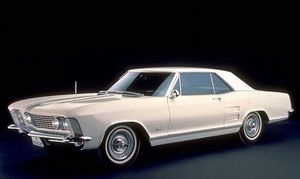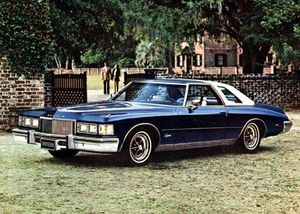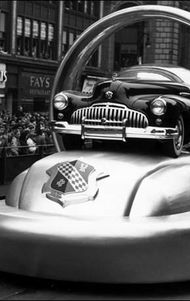.
Buick Riviera

| |
| Buick Riviera | |
|---|---|
| Buick | |
| Years | 1963-1999 |
| Class | Personal Coupe |
| Body Style | 2-Door Coupe |
| Platform | FR E-body (1963-1976) FR B-body (1977-1978) FF E-body (1979-1993) FF G-body (1995-1999) |
| Related | Oldsmobile Toronado Oldsmobile Aurora Cadillac Eldorado |
| Similar | Ford Thunderbird Mercury Cougar Lincoln Mark series |
Add model introduction here.
See Wikicars' comprehensive Buick_Riviera Review.
First generation (1963-1965)
The production Riviera (unusually for a GM product) shared its bodyshell with no other model. It rode a cruciform frame similar to the standard Buick frame, but shorter and narrower, with a 2.0 in (51 mm) narrower track. Its wheelbase of 117 in (2972 mm) and overall length of 208 in (5283 mm) were 6.0 inches (152 mm) and 7.7 in (196 mm) shorter, respectively, than a Buick LeSabre, but slightly longer than a contemporary Thunderbird. At 4190 lb (1900 kg), it was about 200 lb (90 kg) lighter than either. It shared the standard Buick V8 engines, with a displacement of either 401 in³ (6.5 L) or 425 in³ (6.9 L), and Twin Turbine automatic transmission. Brakes were Buick's standard "Al-Fin" (aluminum finned) drums of 12 in. (304.8 mm) diameter. Power steering was standard equipment, with an overall steering ratio of 20.5:1, giving 3.5 turns lock-to-lock.
The Riviera's suspension used the same basic design as standard Buicks, with double wishbones front and a live axle located by trailing arms and a lateral track bar, but the roll centers were raised to reduce body lean. Although its coil springs were actually slightly softer than other Buicks, with the lighter overall weight, the net effect was to make the Riviera somewhat firmer. Although still biased towards understeer, contemporary testers considered it one of the most roadable American cars, with an excellent balance of comfort and agility.
The Riviera was introduced on October 4, 1962 as a 1963 model, with a base price of $4,333, although typical delivered prices with options ran upwards of $5,000. Production was deliberately limited to 40,000 or less to increase demand.
With the same power as the larger Buicks and less weight, the Riviera had sparkling all-around performance: Motor Trend magazine found it capable of running 0-60 mph (0-96 km/h) in 8 seconds or less, the standing quarter mile in about 16 seconds, and an observed top speed of 115 mph (184 km/h), although 125 mph (200 km/h) was feasible with a longer run. Fuel consumption was a meager 13.2 mpg (18.4 L/100 km).
Inside, the Riviera featured a four-place cabin with front bucket seats separated by a center console with floor shifter and storage compartment that was built into the instrument panel, and bucket-style seats in the rear. Upholstery choices included all-vinyl, cloth and vinyl, or optional leather. Popular extra-cost options included a tilt steering wheel, CCC Forum-cruise control, power windows, power seats, air conditioning, AM/FM radio and wire wheel covers.
The Riviera continued with minimal trim changes for 1964 including the discontinuation of leather upholstery from the option list, differing mainly in substitution of the old two-speed Dynaflow-based Twin Turbine for the new three-speed Super Turbine 400, which was marketed as Turbo Hydra-Matic by other GM divisions. This was the first year that the Stylized "R" emblem was used on the Riviera, a trademark that would continue throughout the remainder of Riviera's 36-year production run. Under the hood, the 401 (6.5L) was dropped in favor of the 425 in³ (6.9 L) V8, with 220 SAE HP. A 'Super Wildcat' version was optionally available, with dual Carter AFB four-barrel carburetors, rated at 240 SAE HP.
Changes for 1965 included the introduction of the Gran Sport option, which included the dual-quad Super Wildcat 425 V8, a numerically higher 3.42 axle ratio, dual exhausts, and stiffer, heavy-duty suspension. The 401 (6.5 L)V8 returned as the standard Riviera engine and the Super Turbine 400 transmission now had a variable pitch torque converter like the old Twin Turbine Dynaflow had two years before. Externally, the headlamps were concealed behind clamshell doors in the leading edges of each fender, as in the original design. Further back, the non-functional side scoops between the doors and rear wheel arches were removed, and the taillights were moved from the body into the rear bumper. A vinyl roof became available as an option, initially offered only in black, and the tilt steering wheel optional in previous years was now standard equipment.
Total sales for the three model years was a respectable 112,244. All in all, the Riviera was extremely well-received and considered a great success, giving the Thunderbird its first real competition. This first Riviera is considered a styling landmark, and is quite collectible today.
Second generation (1966–1969)
The Riviera was redesigned for the 1966 model year. It retained its cruciform frame, powertrain, and brakes, but it wore a longer, wider, more curvaceous body, a shell it now shared with the Oldsmobile Toronado, and, a year later, with the Cadillac Eldorado. A notable styling point was the absence of vent windows, a feature GM had introduced with a flourish in the 1930s. Headlamps remained concealed, but they now pivoted up above the grille when not in use. Unlike the Toronado, the Riviera retained a conventional rear wheel drive layout. It was now some 200 lb (90 kg) heavier, so acceleration with the unchanged engines was slightly slower. The Gran Sport package remained available as an option.
Inside, the four-place cabin with front and rear bucket seats and center console was replaced by conventional bench seats as standard equipment, making the Riviera a full six-passenger car for the first time. Optionally available was a Strato bench seat with armrest or Strato bucket seats with either a short consolette or a full-length operating console with a "horseshoe" shaped floor shifter and storage compartment. Both the buckets and Strato bench seat were available with a reclining seat option for the passenger's side.
1967 was substantially the same except for the adoption of Buick's entirely new V8 of 430 in³ (7.0 L) displacement and 360 horsepower to replace the old 425 "nailhead". Powerful Disc brakes with Bendix 4 piston calipers became optional for the front wheels but most Riviera continued to be ordered with Buick's aluminum brake drums which were almost as good.
1968 and 1969 had a reshaped nose and rear bumper as well as hidden wipers. The interior was also new and unlike the 66-67 model, the 1968 shared its instrument panel with the other full size Buick models. There were very few mechanical changes in 1968 but the transmission lost the variable pitch torque converter. Again, Rivieras were available with front bench or bucket seats.
Third generation (1970)
The 1970 was restyled—with exposed headlamps and rear fender skirts. The engine was upgraded to 455 in³ (7.4 L), the largest engine Buick offered to date, rated at 370 gross horsepower (or 245 net horses) and over 500 pounds of torque. Even so, sales dropped in the final year probably because it was becoming overdue for a major styling change and competition from less expensive personal-luxury cars such as the Chevrolet Monte Carlo and Pontiac Grand Prix. But with 227,669 units sold over five seasons, the second-generation Riviera was more successful than the original, if less distinctive.
Fourth generation (1971-1973)
The Riviera was radically redesigned for the 1971 model year with flowing and dramatic "boat-tail" styling. Designed under Bill Mitchell's direction, it was penned by Jerry Hirshberg, future head of design for Nissan, mating the fastback rear window design of the 1963 Corvette Sting Ray coupe to the Riviera's platform. The design was originally intended for the smaller GM A platform, and the use of the Riviera's body—expanded for 1971 by three inches (76.2 mm) in wheelbase and more than 120 lb (55 kg) heavier—produced controversial looks. The 455 engine had a lower compression ratio to meet EPA emissions requirements, reducing power to 225 SAE HP with 250 SAE HP in the Gran Sport. Performance remained reasonably brisk, but the Riviera's sporty image was rapidly fading. One noteworthy advance was Buick's Max Trac system, a traction control system that prevented wheelspin during acceleration on slippery surfaces. Another unique option were rear shoulder belts. Both these advanced options are very rare.
Despite these features, Riviera sales for 1971 dropped to 33,810, the lowest to that time. The 1972 Riviera was little changed, with the 455 engine switching to net power ratings, 225 hp (168 kW) or 250 hp (187 kW) with the Gran Sport, although the actual drop in net power was only 5 hp (4 kW). Sales remained moribund at 33,728. For 1973, the 250 hp engine became standard, with 260 hp (194 kW) on the Stage One, which replaced the Gran Sport, with 34,080 sold.
Fifth generation (1974-1976)
Sixth generation (1977-1978)
Seventh generation (1979-1985)
Eight generation (1986-1993)
Ninth generation (1995-1999)
Styles and Major Options
Reliability
Safety
Photos
Colors
Main Competitors
Unique Attributes
Criticisms
Worldwide
Design quirks and oddities
Awards
See also
External Links
The page uses content from Wikipedia Buick Riviera page and work form these contributors.




